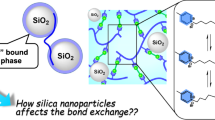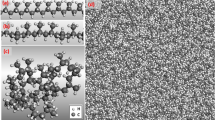Abstract
The effects of tetrahydrofuran (THF) on the physical properties of poly(methyl methacrylate) at (PMMA)/silica nanoparticle interfaces in polymer nanocomposites were investigated via differential scanning calorimetry (DSC), Fourier transform infrared (FT-IR) spectroscopy, and X-ray diffraction (XRD) analysis. Amorphous structures containing PMMA chains with large numbers of trans-gauche conformers were observed in the annealed samples. The amorphous structures in the samples cast from THF suspensions contained PMMA chains rich in trans–trans conformers. These amorphous structures differed from those of neat PMMA prepared without silica. Although the polymer chain mobility was reduced due to interactions between PMMA and the silica nanoparticles, trans–trans-enriched PMMA chains within the amorphous structures were less affected by these interactions. When the amorphous structures were heated above the glass transition temperature of PMMA, the proportion of trans–gauche conformers increased.
This is a preview of subscription content, access via your institution
Access options
Subscribe to this journal
Receive 12 print issues and online access
$259.00 per year
only $21.58 per issue
Buy this article
- Purchase on Springer Link
- Instant access to full article PDF
Prices may be subject to local taxes which are calculated during checkout









Similar content being viewed by others
References
Borges AMG, Benetoli LO, Licínio MA, Zoldan VC, Santos-Silva MC, Assreuy J, et al. Polymer films with surfaces unmodified and modified by non-thermal plasma as new substrates for cell adhesion. Mater Sci Eng C Mater Biol Appl. 2013;33:1315–24.
Giacon VM, da Silva Padilha GS, Bartoli JR. Fabrication and characterization of polymeric optical by plasma fluorination process. Optik. 2015;126:74–6.
Hamdy MS, Alfaify S, Al-Hajry A, Yahia IS. Optical constants, photo-stability and photo-degradation of MB/PMMA thin films for UV sensors. Optik. 2016;127:4959–63.
Chen S, Yang Z, Wang F. Investigation on the properties of PMMA/reactive halloysite nanocomposites based on halloysite with double bonds. Polymers. 2018;10:919.
Okolieocha C, Beckert F, Herling M, Breu J, Mülhaupt R, Altstädt V. Preparation of microcellular low-density PMMA nanocomposite foams: influence of different fillers on the mechanical, rheological and cell morphological properties. Compos Sci Technol. 2015;118:108–16.
Meth JS, Zane SG, Chi C, Londono JD, Wood BA, Cotts P, et al. Development of filler structure in colloidal silica-polymer nanoocomposites. Macromolecules. 2011;44:8301–13.
Kusuyama H, Takase M, Higashihata Y, Tseng H, Chatani Y, Tadokoro H. Structural change of st-PMMA on drawing, absorption and desorption of solvents. Polymer. 1982;23:1256–8.
Kamei D, Ajiro H, Hongo C, Akashi M. Solvent effects on isotactic poly(methyl methacrylate) crystallization and syndiotactic poly(methacrylic acid) incorporation in porous thin films prepared by stepwise stereocomplex assembly. Langmuir. 2009;25:280–5.
Jones RAL, Richards RW. Polymers at surface and interface. Cambridge: Cambridge University Press; 1999.
Karim A, Kumar S. Polymer surface, interface and thin films, World scientific publishing Co. Pte. Ltd, Toh Tuck. Singapore: Link; 2000.
Keddie JL, Jones RAL, Cory RA. Interface and surface effects on the glass-transition temperature in thin polymer films. Faraday Disc. 1994;98:219–30.
Xu J, Liu Z, Lan Y, Zuo B, Wang X, Yang J, et al. Mobility gradient of poly(ethylene terephthalate) chains near a substrate scaled by the thickness of the adsorbed layer. Macromolecules. 2017;50:6804–12.
White RP, Price CC, Lipson JEG. Effect of interfaces on the glass transition of supported and freestanding polymer thin films. Macromolecules. 2015;48:4132–41.
Chen J, Li J, Xu L, Hong W, Yang Y, Chen X. The glass-transition temperature of supported PMMA thin films with hydrogen bond/plasmonic interface. Polymers. 2019;11:601.
Burroughs MJ, Napolitano S, Cangialosi D, Priestley RD. Direct measurement of glass transition temperature in exposed and buried adsorbed polymer nanolayers. Macromolecules. 2016;49:4647–55.
Scheutjens JMHM, Fleer GJ. Statistical theory of the adsorption of interacting chain molecules. 1. Partition function, segment density distribution, and adsorption isotherms. J Phys Chem. 1979;83:1619–35.
Jiang N, Shang J, Di X, Endoh MK, Koga T. Formation mechanism of high-density, flattened polymer nanolayers adsorbed on planar solids. Macromolecules. 2014;47:2682–9.
Jiang N, Endoh MK, Koga T, Masui T, Kishimoto H, Nagao M, et al. Nanostructures and dynamics of macromolecules bound to attractive filler surfaces. ACS Macro Lett. 2015;4:838–42.
Tanaka K, Tateishi Y, Okada Y, Nagamura T, Doi M, Morita H. Interfacial mobility of polymers on inorganic solids. J Phys Chem B. 2009;113:4571–7.
Forrest JA, Dalnoki-Veress K, Stevens JR, Dutcher JR. Effect of free surfaces on the glass transition temperature of thin polymer films. Phys Rev Lett. 1996;77:2002–5.
Perlich J, Metwalli E, Schulz L, Georgii R, Müller-Buschbaum P. Solvent content in thin spin-coated polystyrene homopolymer films. Macromolecules. 2009;42:337–44.
Zhang X, Yager KG, Kang S, Fredin NJ, Akgun B, Satija S, et al. Solvent retention in thin spin-coated polystyrene and poly(methyl methacrylate) homopolymer films studied by neutron reflectometry. Macromolecules. 2010;43:1117–23.
Matsuura K, Matsuda Y, Tasaka S. Influence of tetrahydrofuran and alumina nanoparticle interface on the structure of syndiotactic poly(methyl methacrylate). Kobunshi Ronbunshu. 2018;75:275–9.
Fukatsu H, Kuno M, Matsuda Y, Tasaka S. Surface effect of silica nano-particles with different size on thermotropic liquid crystalline polyester composites. World J Nano Sci Eng. 2014;04:35–41.
Moll J, Kumar SK. Glass transitions in highly attractive highly filled polymer nanocomposites. Macromolecules. 2012;45:1131–5.
Zhang FA, Lee DK, Pinnavaia TJ. PMMA–mesocellular foam silica nanocomposites prepared through batch emulsion polymerization and compression molding. Polymer. 2009;50:4768–74.
Chinthamanipeta PS, Kobukata S, Nakata H, Shipp DA. Synthesis of poly(methyl methacrylate)–silica nanocomposites using methacrylate-functionalized silica nanoparticles and RAFT polymerization. Polymer. 2008;49:5636–42.
Ito A, Ayerdurai V, Miyagawa A, Matsumoto A, Okada H, Courtoux A, et al. Effects of residual solvent on glass transition temperature of poly(methyl methacrylate). Nihon Reoroji Gakkaishi. 2018;46:117–21.
Patra N, Barone AC, Salerno M. Solvent effects on the thermal and mechanical properties of poly(methyl methacrylate) cast from concentrated solution. Adv Polym Technol. 2011;30:12–20.
Bistac S, Schultz J. Solvent retention in solution-cast films of PMMA: study by dielectric spectroscopy. Prog Org Coat. 1997;31:31. 347–50
Feng S, Chen Y, Mai B, Wei W, Zheng C, Wu Q, et al. Glass transition of poly(methyl methacrylate) nanospheres in aqueous dispersion. Phys Chem Chem Phys. 2014;16:15941–7.
Fakhraai Z, Forrest JA. Measuring the surface dynamics of glassy polymers. Science. 2008;319:600–4.
Mansfield KF, Theodorou DN. Molecular dynamics simulation of a glassy polymer surface. Macromolecules. 1991;24:6283–94.
Itagaki H, Nishimura Y, Sagisaka E, Grohens Y. Glass transition of stereoregular poly(methyl methacrylate) at interfaces. Langmuir. 2006;22:742–8.
Eriksson M, Goossens H, Peijs T. Influence of drying procedure on glass transition temperature of PMMA based nanocomposites. Nanocomposites. 2015;1:36–45.
Patra N, Salerno M, Diaspro A, Athanassiou A. Effect of solvents on the dynamic viscoelastic behavior of poly(methyl methacrylate) film prepared by solvent casting. J Mater Sci. 2011;46:5044–9.
Vien DL, Colthup NB, Fateley WG, Grasselli JG. The handbook of infrered and raman characteristic frequencies of organic molecules. New York: Academic Press; 1991.
Tannenbaum R, Hakanson C, Zeno A, Tirrell M. Spectroscopic study of the chemistry at the Cr-PMMA interface. Langmuir. 2002;18:5592–9.
Grohens Y, Brogly M, Labbe C, Schultz J. Interfacial conformation energies of stereoregular poly(methyl methacrylate) by infra-red reflection abspectroscopy. Polymer. 1997;38:5913–20.
Fowkes FM, Kaczinski MB, Dwight DW. Characterization of polymer surface sites with contact angles of test solutions. 1. Phenol and iodine adsorption from methylene iodide onto PMMA films. Langmuir. 1991;7:2464–70.
Ioannis MK, Vassilikou-Dova Aglaia, Eugen RN. Dielectric characterization of poly(methyl methacrylate) geometrically confined into mesoporous SiO2 glasses. Mater Res Innov. 2001;4:322–33.
Tretinnikov ON, Ohta K. Conformation-sensitive infrared bands and conformational characteristics of stereoregular poly(methyl methacrylate)s by variable-temperature FTIR spectroscopy. Macromolecules. 2002;35:7343–53.
Fujii Y, Akabori K, Tanaka K, Nagamura T. Chain conformation effects on molecular motions at the surface of poly(methyl methacrylate) films. Polym J. 2007;39:928–34.
Matsuura K, Matsushita M, Matsuda Y, Tasaka S. Structure of polyacrylate/nanoparticle interfaces. Micro Nano Lett. 2017;12:667–9.
Matsuura K, Matsuda Y, Tasaka S. Metastable interface formation in isotactic poly(methyl methacrylate)/alumina nanoparticle mixtures. Polym J. 2018;50:375–80.
Abbas H, Iqbal S, Ahmad S, Arfin N. Synthesis and characterisation of poly(methyl methacrylate)-silica composites. Mater Res Express. 2018;5:085312.
Ahmad S, Ahmad S, Agnihotry SA. Synthesis and characterization of in situ prepared poly(methyl methacrylate) nanocomposites. Bull Mater Sci. 2007;30:31–5.
Fu HP, Hong RY, Zhang YJ, Li HZ, Xu B, Zheng Y, et al. Preparation and properties investigation of PMMA/silica composites derived from silicic acid. Polym Adv Technol. 2009;20:84–91.
Acknowledgements
This work was supported by Grant-in-Aid for JSPS Research Fellow Number JP19J14528. The XRD measurements were performed at the Ookayama Materials Analysis Division, Technical Department.
Author information
Authors and Affiliations
Corresponding author
Ethics declarations
Conflict of interest
The authors declare that they have no conflict of interest.
Additional information
Publisher’s note Springer Nature remains neutral with regard to jurisdictional claims in published maps and institutional affiliations.
Rights and permissions
About this article
Cite this article
Matsuura, K., Kuboyama, K. & Ougizawa, T. Effect of tetrahydrofuran on poly(methyl methacrylate) and silica in the interfacial regions of polymer nanocomposites. Polym J 52, 1203–1210 (2020). https://doi.org/10.1038/s41428-020-0375-0
Received:
Revised:
Accepted:
Published:
Issue Date:
DOI: https://doi.org/10.1038/s41428-020-0375-0
This article is cited by
-
Synthesis, optoelectronic and thermal characterization of PMMA-MWCNTs nanocomposite thin films incorporated by ZrO2 NPs
Journal of Materials Science: Materials in Electronics (2022)



